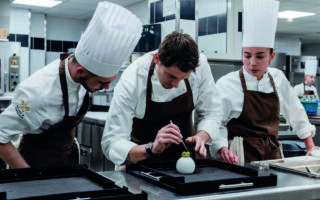
Why is champagne so expensive?
If you’ve ever wondered why champagne costs so much, you’re not alone. But when you know how this most famous wine is made − the time, dedication and passion that is put into it – you may well ask, why is champagne so cheap? Yvonne Halling explains…
Champagne is a complex product: unlike still wines, it undergoes a second and sometimes third process before it reaches the shops. Here’s what happens from grape to glass in a nutshell.

- The vines are planted in the vineyard − keep in mind that the average vine doesn’t bear any fruit for about three years.
- The grapes are harvested by hand – this is because champagne is the only white wine made from black grapes and it’s vital to ensure those dark skins don’t contaminate the clear white juice inside the grapes.
- The grapes are then crushed, mechanically, to extract the juice which is called “must”. The must is then transferred to large vats, usually stainless steel, to begin its first natural fermentation. This is caused by the reaction of the yeast on the skins and the natural sugar in the juice. The process takes about six weeks.
- The cellar master will select various still wines from his reserve collection kept back from previous years’ harvests especially for the purpose of blending – this is to ensure a consistent product. Unlike Bordeaux wine for example, which tastes different from year to year, depending on the weather conditions and suchlike, in Champagne, the aim is to create a similar product every year. The blending process creates a still wine made up of different years, including the current harvest.
- A small amount of new yeast and sugar will be added to the bottle to activate the second fermentation, which takes place in the bottle, so the bubbles cannot escape and we are left with a fizzy wine.
- The bottles are laid down horizontally in the cellar to age. Again, unlike still wine, which is sold almost as soon as it’s been bottled, champagne is laid to rest in the dark underground cellars below the towns and villages of the region for a minimum of 15 months and sometimes up to 10 years.
- Sediment left over from the second fermentation process gets stuck in the bottle. This problem foxed many a cellar master in the past, including Dom Perignon, until later, Veuve Clicquot discovered that by drilling holes in her wooden kitchen table, she could put the bottles into the holes, neck down, and gradually turn them to the right and to the left, into a vertical position, coaxing the fine sediment down to the neck of the bottle. Today, ,this process takes about six weeks and is usually done mechanically, although many of the small champagne producers still do it by hand. It’s called ‘riddling’ or ‘remuage’ in French.
- To remove the sediment, the bottles are plunged neck-down into a freezing solution. A small ice cube forms in the neck, the cap is removed and, bingo, the sediment is gone and the bottles are ready to be corked, washed, labelled and sent off to the shops.
About the author
Yvonne Halling is owner of Les Molyneux, a luxury B&B in the heart of champagne country.
Share to: Facebook Twitter LinkedIn Email
More in Alcoholic, Champagne, Drink, Expensive, Guide, History, Process




REPLY
REPLY